Keynotes 7
The Spread of Buddhism in China
Between
the year 0 B.C.E. and the year 500 Buddhism spread all over China. The concepts of
• compassion,
• salvation
through personal efforts to attain access to nirvana
(a [bodiless in Theravada B. ] heaven, the 'spiritual infinite') and to end
the cycle of suffering, in addition to
• meditation
practice
made the new religion popular in China.
Buddhism
had developed in India as a reaction against the dominance of the caste of
the priests in Hinduism, the Brahmin. Followers of Buddhism objected against
the hierarchy of the caste system and the increasing ritualization in Hinduism.
Nevertheless, Buddhists shared certain principles with Hinduism such as:
•
the concepts of dharma (duty),
• karma
(consequence's of one's actions),
• samsara
(reincarnation), and
• moksha
(nirvana).
•
burning of the dead
•
celibacy of monks [in Theravada Buddhism]
Buddha
(= the Enlightened One; ca. 563 B.C.E. - ca. 480/485 B.C.E.) announced the
path of the Four Noble Truth to reach enlightenemnt and access to nirvana:
1.
Life is suffering. Pain, sorrow, and constant change determine the secular
existence.
2.
The reason for pain is desire and attachment.
3.
Those who give up desire and attachment can stop suffering.
4.
The way to become un-attached is to follow the Eightfold Path of right conduct
which will lead to spiritual perfection.
There
are several schools of Buddhism:
Hinayana
(= Theravada) Buddhism [today practiced in Sri Lanka, Burma, Thailand, Cambodia,
Laos; a mixed form of Theravada and Mahayana Buddhism is practiced in Vietnam]:
Merits can be earned through good deeds.
Mahayana
Buddhism developed between 100 CE and 200 CE into a mass religion. Bodhisattvas
were revered. They are deities who voluntarily have not transcended to the
Buddha existence yet because they decided to act as 'mentors' for those who
are on their way but are in need of spiritual support. According to Mahayana
teaching, charity helps to obtain Buddhahood.
Other
ways to Buddhahood are
meditation (as in contemplative and mystical Chan Buddhism; [=Jap. Zen Buddhism],
repetitive prayer citations of the Buddha's name); moving prayer wheels which
are inscribed with incantations [=Tibet. Lamaistic Buddhism].
Adaptation
into Chinese society was successful because Buddhists offered (and continue
to offer today) important services such as masses for the deceased or (in
earlier times) the storage of coffins in special shelters set up by monasteries.
Coffins
could be stored here until either an auspicious day was proclaimed for the
burial of a certain deceased person or until the relatives had saved the money
for a ritually correct burial.
Buddhist
monasteries became popular not only as a refuge for men or women seeking salvation.
They were also used by wealthy landowners to escape taxation. By donating
land to a monastery landowners could reduce their taxable land. This method
was at times used to such an extent that the government prohibited these donations.
In later times (Tang dynasty) many Buddhist monasteries were closed for a
short period and monks and nuns were forced to return to lay life, because
the reduction of taxable land had led to severe income cuts for the state.
This had no lasting consequences for the religion though.
The
most important Buddhist sects
Tiantai,
(Jap. Tendai): All things contain Buddha nature; most important text: Lotus-sutra
Huayan
('Flower Girland'): all things are interrelated and interdependent
Qingtu
('Pure Land'): faith is the most important way to nirvana; Amitabha (Jap.
Amida), the Buddha of Infinite Light, ruler over the Western Paradise is worshipped
by piously invocating his name just as Avalokitesvara (=Guanyin; Jap. Kannon,
the Boddhisattva of mercy). Faith is the reliable way to nirvana.
Chan
(Jap. Zen): concentrates on silent meditation practices to obtain (instant)
enlightenment (Jap. satori)
The Northern Wei (439-534)
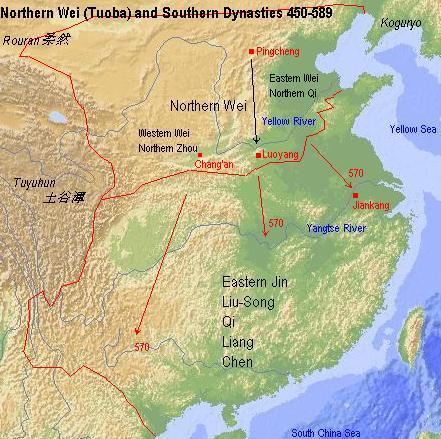
Northern Wei territory
After
centuries of disunity following the relative stability under the Tuoba-Wei,
the first emperor of the Sui dynasty, a general
of Chinese and Turk decendence,
unified the country again. Sui Wendi is
often compared with Qin Shihuangdi:
His
rule followed legalist ideas. He was known as a workaholic who tended to loose
his temper easily. With his eagerness to consolidate power, he first unified
the north, then the south of the country.
Sui
Wendi's support for Buddhism was politically motivated: He used the religion
to create unity as a base for his rule. He also restored the tax system, and
re-established a central government oriented at the Han administration which
laid the foundation for the institutions that were further developed in the
Tang.
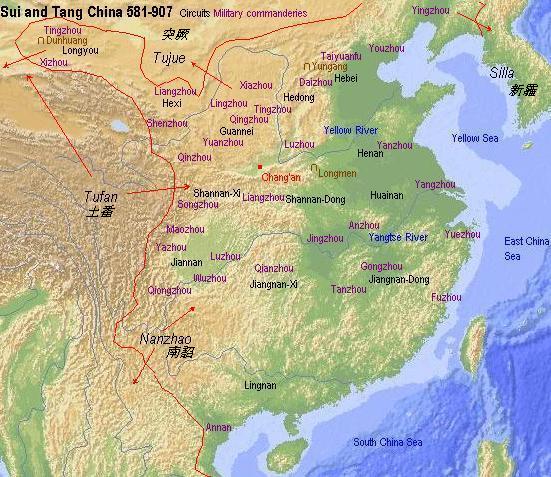
Map
of Sui territory
The
government was headed by the emperor. Three Dukes and Three Instructors functioned
as his advisors, but their positions were less powerful than those of the
The Three Ministers heading the next level of bureaucracy,
the Chancellor, the Bureau of State Affairs, and the Imperial Secretariat
were more influential than the Dukes and Instructors.
The
Bureau of State Affairs had six ministries as subdivisions:
• Personnel
• Revenues
• Rites
• Military
• Justice
• Public Works
In
addition the Censorate was founded and several offices of inspection as
well as the “University” (guozijian) for the sons of the aristocratic elite were established.
Like
Qin Shihuangdi, Sui Wendi became famous for his building activities. He reinforced
the Great Wall and built palaces. The capital was established according to
cosmological principles in Chang’an, the city which
later during the Tang dynasty became the biggest city of the world. He
envisioned to link the waterways of northern and central China, a project
that was finally executed and finished by his son.
The
second emperor of the Sui, Yangdi,
like his father became famous for building activities. He established his capital in the city of
Luoyang, and he built the Grand Canal which linked the Northern plains of the Yellow River and the Southern rice producing areas close
to the Yangzi River. With a width of 40m and a length
of 2.500 km it became a water transportation system and supply network that
remained unmatched in Chinese history. It helped to fill the grain storages
throughout the country.
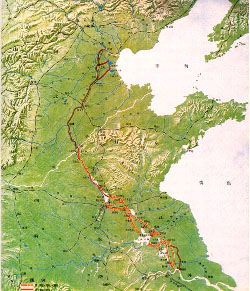
Map of the Grand Canal
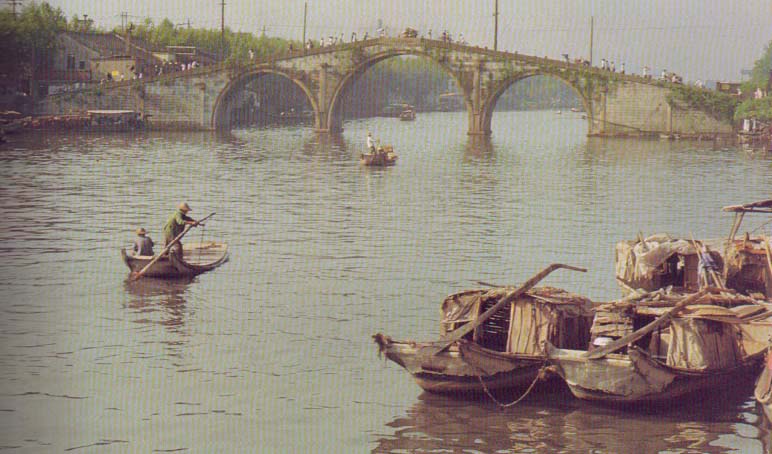
On the Grand Canal
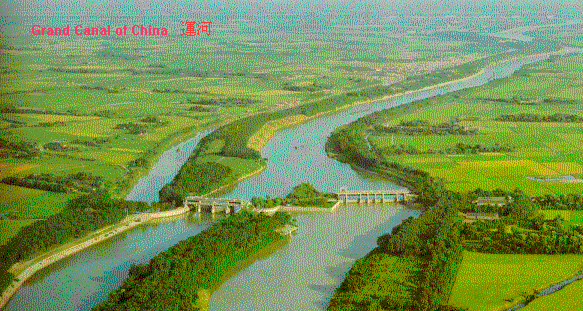
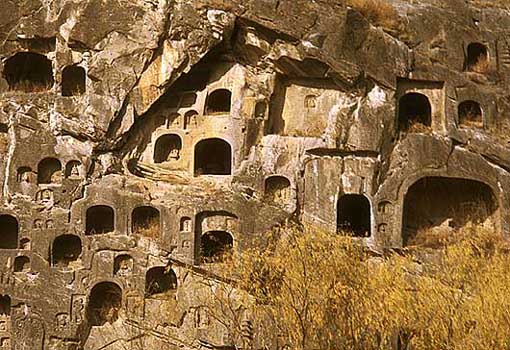
Buddhist caves from the Sui
The
29 years of the reign of the Sui ended when again
warfare at the northern border and against Korea resulted in discontent and rebellion within
the population. Yangdi’s temperament was not any
better than his father’s and finally Li Yuan, a general related to the imperial
clan was the successful winner among the contenders for power. One of the few emperors who found himself in a conflict between his
loyalty to the previous dynasty and his conviction that a new rule was inevitable,
he founded the Tang Dynasty (618-907).
Due
to the praise in traditional Chinese historiography to this day the Tang remains
the very symbol of Chinese high culture. Military expansion and political
grandeur, the cosmopolitan capital of Chang’an,
which was the biggest city in the world at the time, where all luxuries known
were available, and a centralized state with institutions that should prevail
and influence the political order of the neighboring states of Vietnam, Korea,
and Japan, contributed to the legacy of the Tang.
The Tang Dynasty (618-907): The Golden,
Cosmopolitan Age of Chinese Civilization and the Final Period of Aristocratic
Rule
Although
Li Yuan, the founder of the Tang, was a popular emperor, his rule was short:
It only lasted from 618 to 626. He was popular because he did not
kill his opponents. Instead he tried to integrate them into his political
system and had mercy for the soldiers of his enemies. He acted somewhat similar
to the Zhou kings of antiquity who intergated members of the former ruling
house of the Shang into their political system.
Tang
emperor Taizong
Li
Yuan's sons, the Tang princes, competed for the succession to the throne while
their father was still in power.
Blackmailing
and jealousy between the three brothers led to a barbaric act committed by
Li Shimin. The second son and most successful military leader
in the family killed the eldest son and heir apparent as well as their younger
brother. Subsequently, Li Yuan abdicated and left the throne to Li Shimin.
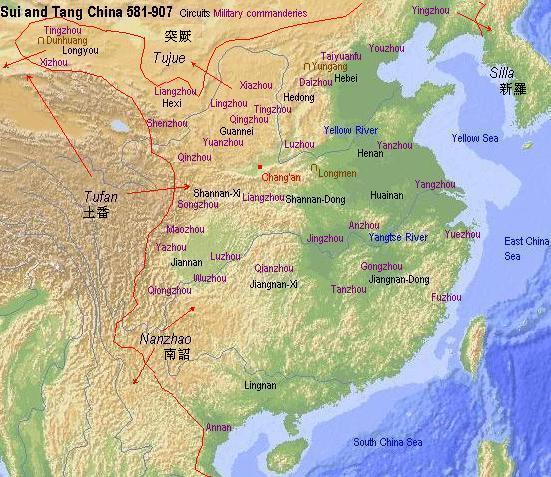
Tang
Territory
Successful
as he was, Chinese historiography describes Li Shimin
as a man of education. He was well read in the Confucian Classics, historiographical
sources, had practiced calligraphy, and was a devout Buddhist. Once
in power he seems to have tried to change the records of the palace historians
in order to avoid that the beginning of his rule would be associated with
the murder of his brothers forever. In this he was not entirely successful.
Yet
he was a tireless worker and after a few years of trying to gain fame for
himself as a model ruler according to Confucian standards,
he fell back into the behaviour of the Sui emperors and
started extensive building activities. It was under his rule that the capital
Chang’an became the famous metropolis it was to remain throughout
history.
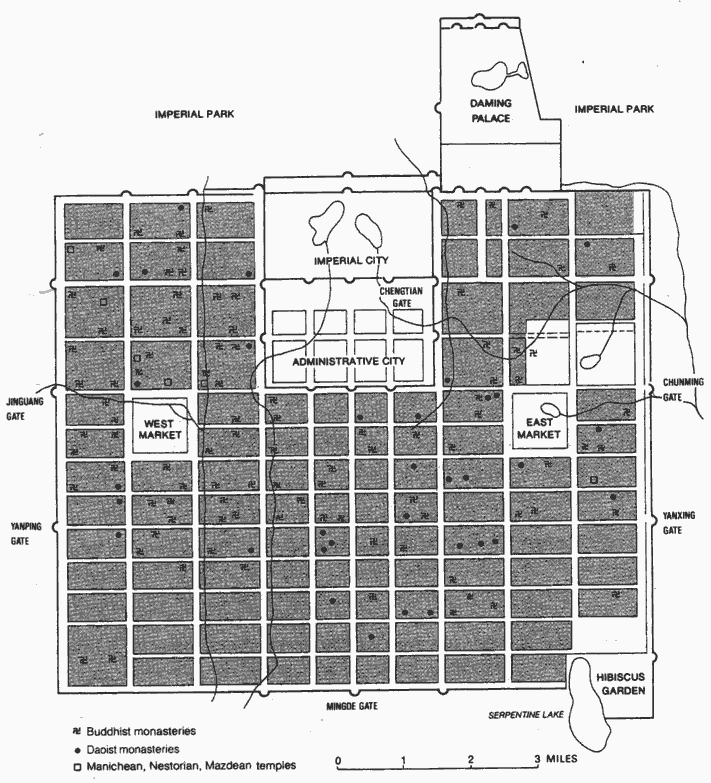
Tang Chang'an
The
layout of Tang Chang'an was a rectangular grid, with streets running in North-Southern
and East-Western direction in equal distance to each other. Residential quarters
and the two central markets - the western international market with its offers
of commodities from the silkroad, its hostels, restaurants, and brothels,
and the eastern market which offered local products and supplied the households
of the officials with everyday goods such as clothing and food as well as
paper, brushes, ink, as well as the winehouses and courtesan quarters etc.-
were arranged in walled quarters. Opening hours of the markets were regulated
and a market overseer controlled the prices. There was a nightly curfew and
residents who did not return to their wards in time faced closed ward gates.
When caught they were punished severely. Exemptions from the curfew were made
only for doctors on their way to a patient as well as for members of the Buddhist
clergy.
In
the Tang the system of centralized government institution became more elaborate
than that of the Sui. Based on the Sui model the
Censorate became even more powerful than before by having
the right of reporting directly to the emperor and remonstrate with the emperor
when the officials felt it to be necessary.
Foreign
envoys were frequent visitors to the Tang court. They came from Japan, Persia,
Byzanz, the Korean state of Silla, and the Sassanids.
Emperors
were patrons of institutions of higher education, like the Hanlin Academy,
the most influential academy of China which was founded in the Tang. Editions
of the Classics were established as the basic knowledge for the participation
in the examination system with written exams. [The exams were aiming at a
high level of objectivity in grading: Every student was given a number and
his exam papers were copied by a clerk and marked with the assigned number.
After the papers were graded, numbers and names were matched again before
the results were announced publicly. ] This system became established in the
Tang, was further developed in the Song (906-1279) and remained throughout
Chinese, Korean, and Japanese history the most important selection process
for the appointment of officials.
But in this early stage only 10 % of the officials were
recruited for office in accordance with their merits. 90% were recommended
for an official position.
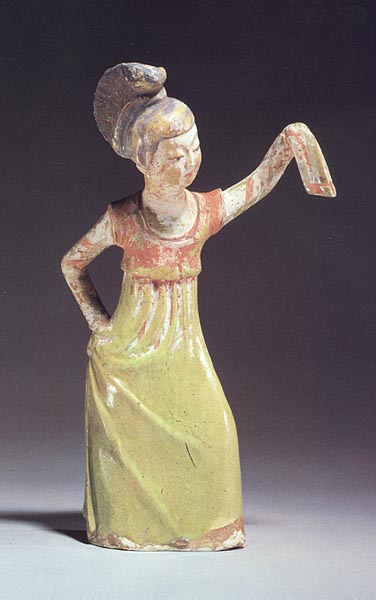
Funerary statue
of a female dancer
Women
of the upper classes enjoyed considerable liberties in Tang society. They
were involved through their clan membership in political decisions: Wu Zetian,
originally consort of Tang emperor Gaozong became the (only) empress of China.
From 690 to 705 CE she ruled as the empress of the Zhou Dynasty. Though she
was treated with scorn by the Confucian officials, she managed to conduct
a rather successful land reform. With a skill and ruthlessnes that matched
her male predecessors well she consolidated her power successfully.
Women
at the time engaged in poetry, they also rode horses, played polo, and traveled.
Wu
Zetian supported Buddhism on a large scale. She associated herself closely
with this non-aristocratic, anti-hereditary ideology and had herself celebrated
as the re-incarnation of Maitreya. Just like many emperors before her she
became a patron of Buddhist temples. The Buddhist statutes of Longmen and
the famous caves of Dunhuang are a testimony for the tremendous acceptance
Buddhism received.
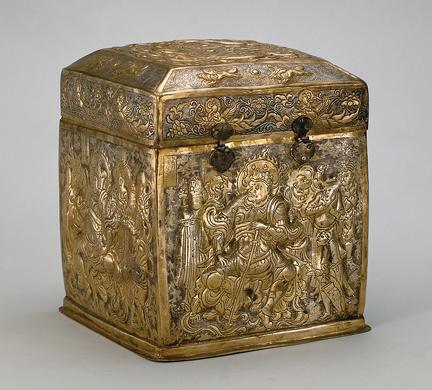
Reliquary
from the underground palace of Famen Temple; gilded silver, decorated with
the Buddhist protective deities of the four directions (h 23,5 cm, w. 20,2
cm, w. 699 g).
The
precious objects found in the underground palace of Famen temple pagoda which
was destroyed during an earthquake were donations made by Tang emperors when
the temple was built.
The
Tang was the period when due to Central Asian influence, or better, the due
to the influence of skilled artisans on the silkroad, objects made from gold
and silver like the reliquary shown above became popular.
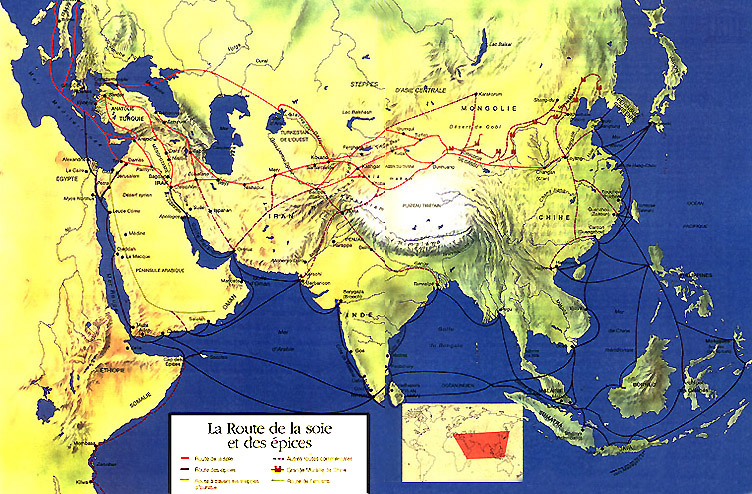
The
silkroad functioned as a route of exchange for goods and ideas were ex- and
imported. Buddhist scripts and iconography in the arts came from India and
the states along the silkroad, spices, and medicines came from India, polo,
glass and silver objects were imported from Persia, horses and furs came from
Central Asia.
China's
exports via the silkroad consisted of silk, porcelain, and artisans who mastered
papermaking and metalworks.
During
the Tang Dynasty northern Vietnam, Xinjiang, southern Manchuria, and Korea
as a tribute state were incorporated into the Chinese sphere of political
influence.










